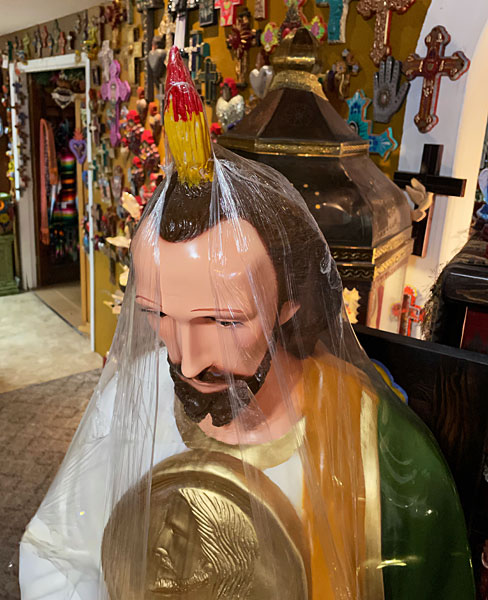We were recently in Fort Stockton and while we were there, we visited one of our favorite stores, Bella Terrazas. Bella Terrazas is owned and managed by Amy Terrazas, a special family friend, and the store is filled from floor to ceiling with an amazing variety of decor, almost all of which was hecho en México. We can spend an hour or more just browsing through the store’s inventory (and visiting with Amy)…and it’s rare that time isn’t all we spend there, IYKWIM.
One section of the store is dedicated to Roman Catholic icons and symbols, which are exotic and sometimes puzzling to our Southern Baptist eyes. But we saw something on this visit that raised our puzzlement to previous uncharted heights:

I confess that my first thought after seeing this five-feet-tall, shrink-wrapped statue was “why does Jesus have a bloody stake coming out of His head?” (And I mean no disrespect whatsoever to adherents to the Catholic faith.)
It didn’t occur to me to ask Amy for an explanation; after all, she’s not a tour guide and we certainly weren’t the target purchasing audience. So I waited until we got home to try to find an explanation for what this statue represented.
My extensive research — literally minutes of googling — was initially frustrating. Search terms like “statue of Jesus with a candle on His head” (I had decided that surely that wasn’t a stake) led nowhere. I decided to cast a wider net, and eventually searching for images of “Mexican saint candles” took me to what seemed like some promising leads. I had to wade through prayer candles dedicated to Keanu Reeves (?!) and other “celebrities” but I finally scrolled down to a tiny image of Saint Jude with what appeared to be a light on top of his head.
So, I googled “Mexican St Jude statues” and found that this is a common portrayal of Jude the Apostle. I eventually landed on this website dedicated to him, and it answered all of my questions, and more, about the symbology of the statue pictured above.
The “candle” is actually a flame and it represents the descending of the Holy Spirit on the apostles at Pentecost (see the biblical reference: Acts 2:3-4). The medallion held by the statue is embossed with the likeness of Jesus, and its significance is explained on the website linked in the preceding paragraph. Even the green color of the statue’s robe is symbolic, as it represents hope and renewal (and of course even many of us Protestants know Jude as the patron saint of lost causes, and even if we’re not, we know the good work being done by St. Jude Children’s Hospital).
I don’t care to get into any kind of theological discussions surrounding the veneration of saints, mainly because I’m not qualified (although that’s rarely stopped me before). But I’m afflicted with a natural curiosity about things like this, and enjoy learning more about the world around me. I suspect I share this trait with some of you, and I hope this meandering trail led you to some new observations of your own.
Discover more from The Fire Ant Gazette
Subscribe to get the latest posts sent to your email.
